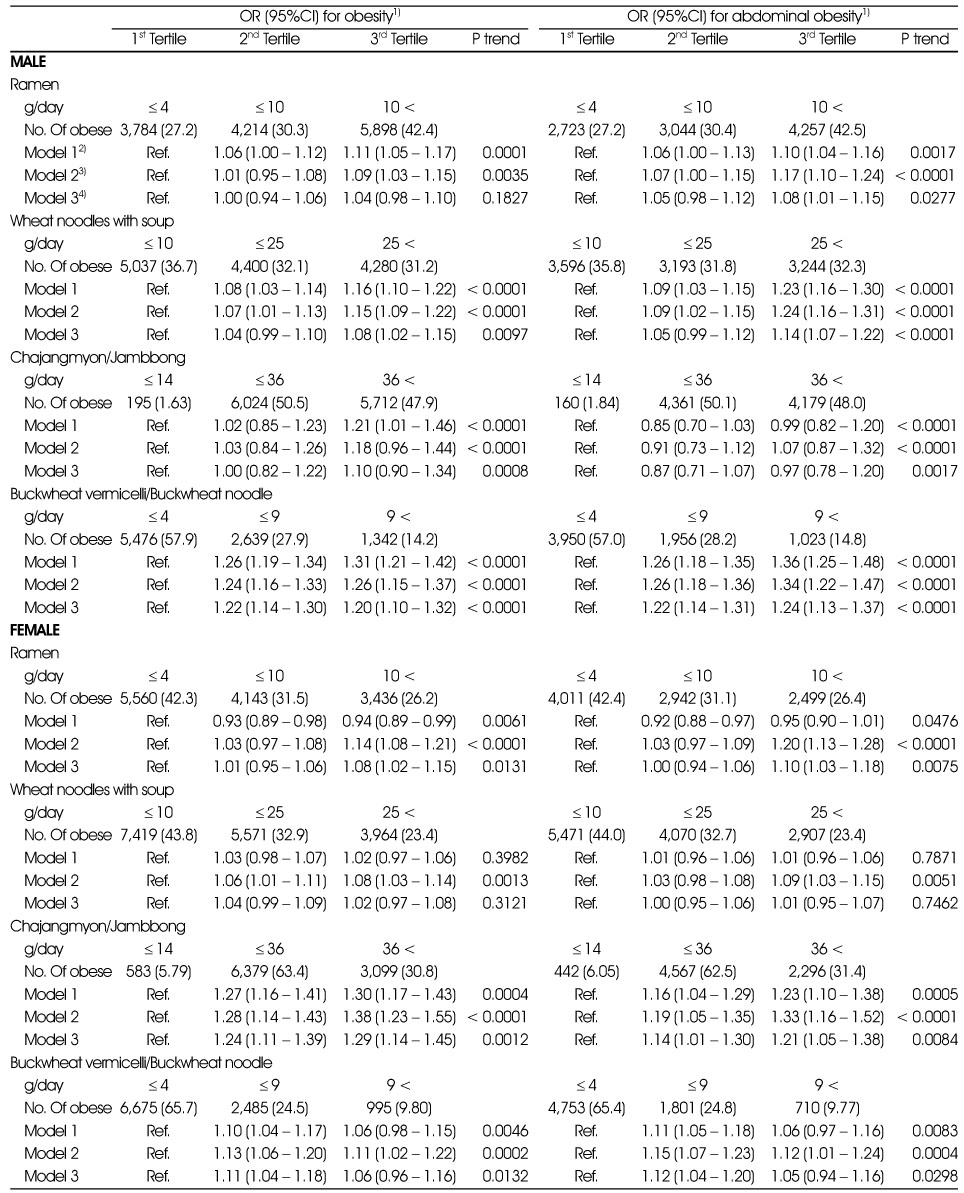Articles
- Page Path
- HOME > Korean J Community Nutr > Volume 22(2); 2017 > Article
-
Research Article
- Distribution and Exposure Prevalence of Carbohydrate-based Food Intake among Obese Korean Adults Based on the Health Examinees (HEXA) Study
-
Yuri Han, Sung-Ok Kwon, Sang-Ah Lee

-
Korean Journal of Community Nutrition 2017;22(2):159-170.
DOI: https://doi.org/10.5720/kjcn.2017.22.2.159
Published online: April 30, 2017
Department of Preventive Medicine, Kangwon National University School of Medicine, Gangwon-do, Korea.
- Corresponding author: Sang-Ah Lee. Department of Preventive Medicine, Kangwon National University School of Medicine, 1, Gangwondaehak-gil, Gangwon-do, 24341, Korea. Tel: (033) 250-8871, sangahlee@kangwon.ac.kr
Copyright © 2017 The Korean Society of Community Nutrition
This is an Open-Access article distributed under the terms of the Creative Commons Attribution Non-Commercial License (http://creativecommons.org/licenses/by-nc/3.0/) which permits unrestricted non-commercial use, distribution, and reproduction in any medium, provided the original work is properly cited.
- 535 Views
- 3 Download
- 5 Crossref
Figure & Data
REFERENCES
Citations

- Calcium- and Sodium-Rich Food Intake among Koreans with and without Metabolic Syndrome: Cross-Sectional Analysis of the Korean Genome and Epidemiology Study
Byeonggeun Choi, Jiyoon Kim, Yeonjin Kim, Jiae Shin, Sang-Ah Lee
Nutrients.2024; 16(15): 2439. CrossRef - In vitro safety and efficacy of probiotics mixture
on carbohydrate digestion inhibition
Eunsol Seo, Jang-Bin Woo, MinYeong Seo, Jeongmin Woo
Korean Journal of Food Preservation.2023; 30(3): 538. CrossRef - Assessment of dietary quality and nutrient intake of obese children in Changwon area
Ji-Sook Park, Ha-Neul Choi, Jae-Young Kim, Sang-Hyuk Ma, Jung-Eun Yim
Journal of Nutrition and Health.2022; 55(6): 630. CrossRef - Comparison of the levels of energy intake from dish and food groups by gender and age among Korean obese adults: data obtained from the 2013-2018 Korea National Health and Nutrition Examination Survey
Cheongmin Sohn, Woori Na, Chaeryeon Kim, Seunghee Choi, Oh Yoen Kim, Jounghee Lee, Mi Ock Yoon, Myoungsook Lee
Journal of Nutrition and Health.2022; 55(6): 670. CrossRef - Relationship between Obesity and Dental Caries in Some University Students: A Pilot Study
SooJeong Hwang, Hoon Kim, MinSeock Seo
Journal of Dental Hygiene Science.2021; 21(2): 127. CrossRef
Characteristics of the study subjects according to the quintile categories of total carbohydrate intake
P values were calculated by chi-square test
Odds ratios and 95% confidence interval for obesity according to the distribution of total carbohydrate intake and major carbohydrate source foods
1) Obesity: BMI ≥ 25 kg/m2, Abdominal obesity: Waist Circumference M ≥ 90/F ≥ 85
2) Model 1: Crude
3) Model 2: Adjusted for age, sex, education, job, married, income
4) Model 3: Adjusted for Model 2 + drinking status, smoking status, exercise, total energy intake
Distribution of carbohydrate source foods intake according to the noodle intake
1) Model 1: Adjusted for age, sex
2) Model 2: Adjusted for age, sex, education, job, married, income, total energy intake
Odds ratios and 95% confidence interval of obesity according to the noodle intake in Korean adults
1) Obesity: BMI ≥ 25 kg/m2, Abdominal obesity: Waist Circumference M ≥ 90/F ≥ 85
2) The tertile for g/day for each noodle
3) Model 1: Crude
4) Model 2: Adjusted for age, sex, education, job, married, income
5) Model 3: Adjusted for Model 2 + drinking status, smoking status, exercise, total energy intake
Odds ratios and 95% confidence interval of obesity according to the noodle intake by gender
1) Obesity: BMI ≥ 25 kg/m2, Abdominal obesity: Waist Circumference M ≥ 90/F ≥ 85
2) Model 1: Crude
3) Model 2: Adjusted for age, sex, education, job, married, income
4) Model 3: Adjusted for Model 2 + drinking status, smoking status, exercise, total energy intake
P values were calculated by chi-square test
1) Obesity: BMI ≥ 25 kg/m2, Abdominal obesity: Waist Circumference M ≥ 90/F ≥ 85 2) Model 1: Crude 3) Model 2: Adjusted for age, sex, education, job, married, income 4) Model 3: Adjusted for Model 2 + drinking status, smoking status, exercise, total energy intake
1) Model 1: Adjusted for age, sex 2) Model 2: Adjusted for age, sex, education, job, married, income, total energy intake
1) Obesity: BMI ≥ 25 kg/m2, Abdominal obesity: Waist Circumference M ≥ 90/F ≥ 85 2) The tertile for g/day for each noodle 3) Model 1: Crude 4) Model 2: Adjusted for age, sex, education, job, married, income 5) Model 3: Adjusted for Model 2 + drinking status, smoking status, exercise, total energy intake
1) Obesity: BMI ≥ 25 kg/m2, Abdominal obesity: Waist Circumference M ≥ 90/F ≥ 85 2) Model 1: Crude 3) Model 2: Adjusted for age, sex, education, job, married, income 4) Model 3: Adjusted for Model 2 + drinking status, smoking status, exercise, total energy intake

 KSCN
KSCN






 PubReader
PubReader Cite
Cite


